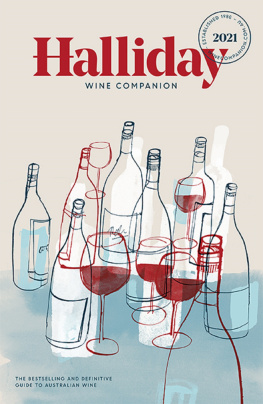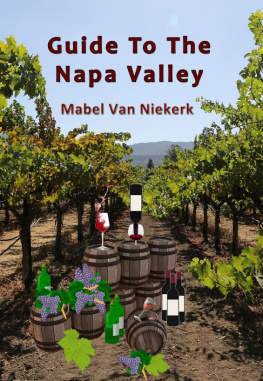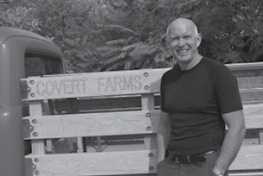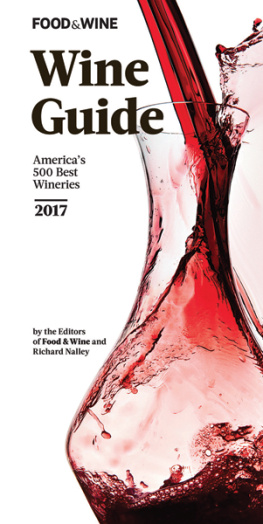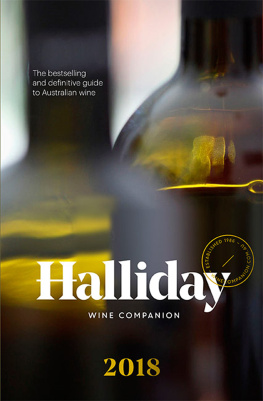
CONTENTS
LEBANON
If theres one thing that sets wine apart from other drinks, its the fact that it can taste different depending on where it comes from. Sure, winemakers have an influence of course they do. But you can take grapes from two different vineyards, treat them exactly the same way and each will have its own distinctive character sometimes even if the vineyards are only a few metres apart. The French, as you might expect, have a word for it: terroir the untranslatable term that takes in everything from climate and vineyard orientation to soil and the general habitat.
And that, frankly, is what this book is all about. Because drinking a wine at home is one thing, drinking it in the place where its grown quite another. Being able to take in the terroir as you sip is the difference between colour TV and high-definition 3D it all just seems more, well real.
Slither your way up the slatey slopes of the Mosel, or crunch across the alluvial soils of the Mdoc, and the cool, stony punch at the heart of the wines starts to make sense. Taste the light-footed lift of an English white wine or the tang of a manzanilla sherry, and youll remember the chalky breeze on your face in the Hampshire vineyard, the whisper of sea-salt and anchovies of an Andalucian lunchtime. And going there doesnt just connect you to the land, but to the past as well.
As you kick up dust-trails in the heat of the Douros terraced vineyards its easy to imagine square-sailed barcos carrying their casks of port to the waiting cellars, warehouses and merchant ships of Porto hundreds of years ago. Visit the original house of Dr Christopher Penfold outside Adelaide or the old cellars of Ksara in Lebanon and you are in the places that gave birth to an entire countrys wine industry. Its a pilgrimage as much as a visit. Taste in situ, in other words, and flavours, history, terroir they all start to make sense.
Clearly, given there are tens of thousands of wineries in the world, its not possible to cover everything. But in this book Ive tried to cover as many countries and regions as I can, so wherever you happen to be or are thinking of going, there should be great visits within striking distance.
We go from some of the highest vineyards in the world to ones practically dipping their toes in the sea. From vineyards on the edge of cities to ones that are perfect for seekers of solitude. From wineries steeped in tradition to new arrivals intent on ripping up the rule book.
There are visits with games for kids, swimming pools, zip-wires and boules, and others that are little more than a shack with passionate staff; places where you can ride horses and bikes through the vineyard, and ones with slick visitor experiences. All manner of life is here.
So whether youre a seasoned visitor or a first-timer, a retiree or a student, a young couple or a young family, I hope you will feel inspired to visit. Partly because there are bound to be dozens of wineries out there that are perfect for you. But mostly because, in wine, what you taste and where you taste are the same thing, and making that connection is the most thrilling thing of all.

If you were to force an oenophile, sommelier, drinks writer or wine trader to choose wines from just one country to drink for the rest of their life, most would probably pick those of France. Charles de Gaulles land of 246 types of cheese also makes wines in a staggering array of styles, many of them reference points for the world.
I wonder if theres ever been a greater dislocation between a place and its product? After all champagne the drink is glamour, celebration and bling; flappers, Art Deco and the Roaring Twenties; Oscars and anniversaries. Yet the countryside of Champagne the region is as forgettable as a party-bores joke.
The drive from Calais could be fairly renamed 300km of nothing just pale wheat field after pale wheat field offering horizons more Oklahoma than Orlans. And anyone whos been looking for a place to kill a couple of hours on their way back to the Eurostar will know that, bar the odd First World War battle site, non-wine-related tourism options in this north-eastern corner of France could politely be described as limited.
But from this landscape, Reims rises like an oasis: a buzzy, food-centred town chock-full of history, restaurants and, of course, champagne. Its the drinks unofficial capital, and names that youll recognise from wine lists and retailers shelves around the world are everywhere.
Southwards from the city lie a cornucopia of vineyards, wineries and ancient cellars. Annoyingly, many of the most famous houses arent open to tourists at all not even by ringing ahead but theres still a decent selection of bigger players, small growers and a sprinkling of co-operatives that will open their doors (and cellars) to you.
Unless youre a serious champagne anorak, I doubt youd choose Reims for a two-week holiday, but its a good place to visit for a long weekend, en route to Alsace and Germany or even as part of a 24-hour whistle-stop visit from Paris, which is commutably close to the west.
One piece of advice: dont visit in the darker months. The coldest Ive ever been was in a wine cellar in Champagne, and this particular part of northern France can be bleakly, damply, unforgivingly bone-chilling in winter. A day trudging numbly round the cold muddy vineyards in January can only make you wonder at the fortitude of the soldiers who spent month after month in the trenches that ran through the heart of this region 100 years ago.
As you reach for a second jumper, however, you can comfort yourself with the knowledge that this chilliness is very much part of the secret of Champagne.
These are Frances most northerly vineyards, and they shouldnt be able to produce ripe grapes at all. Indeed, if they were planted on the flat, marly plains, they simply wouldnt. But just south of the city lie the curved slopes of the Montagne de Reims and, south of that, of the Cte des Blancs. Vines here use the slopes like a sun-lounger, banking up to absorb the rays, shielded from the westerly winds, and luxuriating in the chalky soils that drain well and also retain heat. This allows the grapes to get to the perfect level of almost ripeness that you want for champagne of apple and citrus flavours and that thrilling crispness thats so key to all top fizz.
Champagne is a story of three grape varieties. Theres Pinot Noir, which youll find scattered around the eastern and southern slopes of the Montagne de Reims. Its cheerful, less intellectual relative, Pinot Meunier, plays along the banks of the Marne river, while the Cte des Blancs, just south of pernay, is the spiritual home of the zesty and elegant Chardonnay grape.
In such a marginal climate, different areas and different grapes tend to perform very differently from one year to the next, which is where Champagnes great USP comes in: blending. Of course, you can get vintage champagne (made from one year), single-varietal champagne (made from one grape variety) and single-vineyard champagne (made from one site). But the regions success has been built on mixing everything together in the name of consistency: different grape varieties, different areas and in the case of non-vintage champagne, which makes up the vast majority of the regions production different years.
Use any trip to the region to get a handle on this diversity: visit a couple of small growers who specialise in certain areas to see what makes their village special, as well as a co-operative or larger producer that takes fruit from across the region to understand blending.



